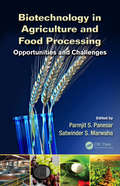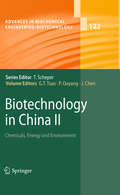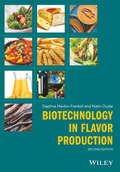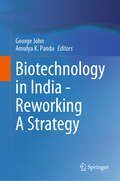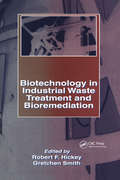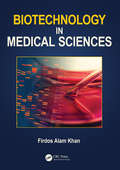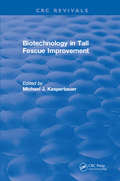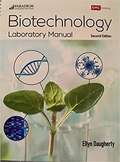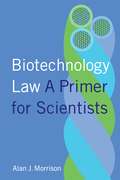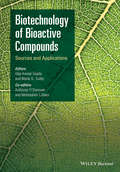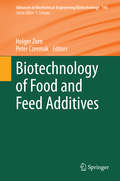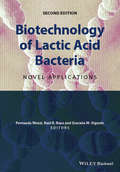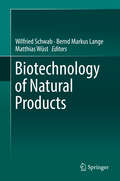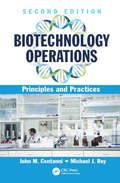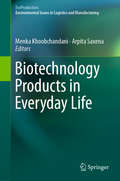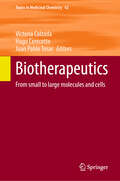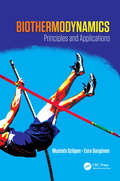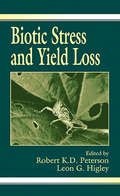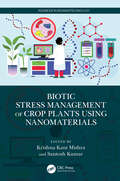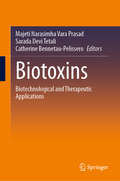- Table View
- List View
Biotechnology in Agriculture and Food Processing: Opportunities and Challenges
by Parmjit S. Panesar Satwinder S. MarwahaAn instructive and comprehensive overview of the use of biotechnology in agriculture and food production, Biotechnology in Agriculture and Food Processing: Opportunities and Challenges discusses how biotechnology can improve the quality and productivity of agriculture and food products. It includes current topics such as GM foods, enzymes, and prod
Biotechnology in China II: Chemicals, Energy and Environment (Advances in Biochemical Engineering/Biotechnology #122)
by Jian Chen Pingkai Ouyang G. T. TsaoPast, Present, and Future Industrial Biotechnology in China, by Zhenjiang Li, Xiaojun Ji, Suli Kan, Hongqun Qiao, Min Jiang, Dingqiang Lu, Jun Wang, He Huang, Honghua Jia, Pingkai Ouyuang, and Hanjie Ying.- Organic Chemicals from Bioprocesses in China, by Jin Huang, Lei Huang, Jianping Lin, Zhinan Xu, and Peilin Cen.- Biofuels in China, by Tianwei Tan, Jianliang Yu, Jike Lu, and Tao Zhang.- Bioreactors and Bioseparation, by Siliang Zhang, Xuejun Cao, Ju Chu, Jiangchao Qian, and Yingping Zhuang.- Environmental Biotechnology in China, by Shuang Jiang Liu , Lei Liu , Muhammad Tausif Chaudhry , Lei Wang , Ying Guang Chen , Qi Zhou , He Liu , and Jian Chen.- Traditional Chinese Biotechnology, by Yan Xu , Dong Wang , Wen Lai Fan , Xiao Qing Mu, and Jian Chen.- Modern Biotechnology in China, by Qing-Zhao Wang and Xue-Ming Zhao.
Biotechnology in Flavor Production
by Nativ Dudai Daphna Havkin-FrenkelThroughout history, human beings have sought ways to enhance the flavor of the foods they eat. In the 21st century, biotechnology plays an important role in the flavor improvement of many types of foods. This book covers many of the biotechnological approaches currently being applied to flavor enhancement. The contribution of microbial metabolism to flavor development in fermented beverages and dairy products has been exploited for thousands of years, but the recent availability of whole genome sequences of the yeasts and bacteria involved in these processes is stimulating targeted approaches to flavor enhancement. Chapters discuss recent developments in the flavor modification of wine, beer, and dairy products through the manipulation of the microbial species involved. Biotechnological approaches to the production of specific flavor molecules in microbes and plant tissue cultures, and the challenges that have been encountered, are also covered, along with the metabolic engineering of food crops for flavor enhancement - also a current area of research. Biotechnology is also being applied to crop breeding through marker-assisted selection for important traits, including flavor, and the book looks at the application of the biotechnological approach to breeding for enhanced flavor in rice, apple, and basil. These techniques are subject to governmental regulation, and this is addressed in a dedicated chapter. This updated second edition features five brand new chapters, and the topics covered in the book will be of interest to those in the flavor and food industries as well as to academic researchers interested in flavors.
Biotechnology in Functional Foods and Nutraceuticals
by Debasis Bagchi Francis C. Lau Dilip K. GhoshModern food biotechnology is now a billion-dollar industry, producing functional foods and nutraceuticals that offer a whole host of increased health benefits, including prevention against illness, and chronic and degenerative conditions. Written by a team of top-tier researchers and scientists from around the world, Biotechnology in Functional Foo
Biotechnology in India - Reworking A Strategy
by George John Amulya K. PandaThis book examines the progress in the biotechnology sector in India towards knowledge and innovation driven Bioeconomy. The chapters of the book review different genome editing techniques and the GM crops focusing on the emerging potential in agricultural biotechnology. Chapters on Vaccines and AI in healthcare unfold huge opportunities in medical biotechnology. The book covers the advances in biotechnology towards delivering important benefits of healthcare, particularly through the pharmaceutical industry focusing on new healthcare interventions and delivering innovations. Further, it explores the major opportunities in industrial biotechnology related to bio-pharma, biorefinery, fermentation biotechnology, and growing synergies between industry-academia. Toward the end, the book also reviews the genetic regulation and the critical role of HRD. In summary, the book emphasizes on India as a strong bio-manufacturing hub for innovative, affordable and accessible products for the society and also for global markets while describing the sector wise strategies required.
Biotechnology in Industrial Waste Treatment and Bioremediation
by Gretchen Smith Robert F. HickeyBiotechnology in Industrial Waste Treatment and Bioremediation addresses the increasingly important topic of waste treatment. Focusing on microbiological degradation of contaminants, it offers a representative picture of the current status of environmental biotechnology and lays a solid foundation of the methods and applications of bioremediation. The expert presentations of case studies in this new book demonstrate successful treatment schemes and technologies meeting regulatory standards. These case studies represent an international cross-section of strategies for developing and implementing the evolving technologies of bioremediation. Biotechnology in Industrial Waste Treatment and Bioremediation examines the primary waste streams, including air, water, soils, and sediments, and explores specific treatment methodologies for industrial and environmental contaminants. This broad and unique coverage allows treatment firms and regulatory authorities to determine and develop appropriate treatment strategies for site-specific problems of waste remediation. The observations and successful field applications compiled in Biotechnology in Industrial Waste Treatment and Bioremediation make it an excellent reference for understanding, evaluating, developing, and operating efficient and cost-effective full-scale treatment systems.
Biotechnology in Medical Sciences
by Firdos Alam KhanAs the field of medical biotechnology grows with new products and discoveries, so does the need for a holistic view of biotechnology in medicine. Biotechnology in Medical Sciences fulfills that need by delivering a detailed overview of medical biotechnology as it relates to human diseases and epidemiology, bacteriology and antibiotics, virology and
Biotechnology in Tall Fescue Improvement
by Michael J. KasperbauerThis one-of-a-kind publication focuses on the improvement of the feed value of tall fescue and further extension of its adaptability under various environmental stresses. This fascinating work comprehensively explains cell and tissue culture methods which are used to establish somatic cell cultures, select among cells, and regenerate plants with the genetic characteristics of the selected cells. This up-to-date volume includes information on cultural haploid plants from immature pollen grains. It also evaluates the plants under various environmental stresses to identify genotypes with superior characteristics. This book also features research data on somatic tissue culture methods and doubled haploids. Biotechnology in Tall Fescue Improvement is an indispensable resource and useful text for all those involved with agronomy, plant physiology, horticultural science, crop science, and botany.
Biotechnology in the generation of biofuels (Interdisciplinary Biotechnological Advances)
by Maria del Pilar Rodriguez-Torres Claudia Martinez-AlonsoThis book approaches biofuels from a new biotechnological perspective with the aim of equipping researchers with a thorough, up-to-date understanding of biofuel research and related technologies. Topics include biomethane, bioethanol, biobutanol, biomass, hydrolysis, bio-oil, microbiology, and many more. Biofuel research has evolved mechanisms to advance their utilization and their application in our system. The chapters will provide concise and up-to-date information to aid our understanding of biotechnology-related implications of biofuels development and its advancements. Readers in the areas of bioengineering, sustainability, renewable energies and biotechnology will find this work useful to widen their knowledge and perspectives on biofuels.
Biotechnology Laboratory Manual
by Ellyn DaughertyBiotechnology Laboratory Manual Second Edition by Ellyn Daugherty
Biotechnology Law: A Primer for Scientists
by Alan MorrisonBiotechnology and law are inextricable. Patent, regulatory, and contract law profoundly shape the biotech industry, and each of these practice areas is deeply intertwined with the science it governs. Yet many in this industry lack even a basic grasp of these laws, jeopardizing their business success as a result.This book is an essential introduction to biotechnology law for scientists, startup founders, regulatory specialists, patent liaisons, investors, academics, students, and other nonattorneys with biotech backgrounds. It covers core topics such as patentability, patent prosecution and infringement, patent opinions, the development and FDA approval of small-molecule and biologic drugs, regulatory exclusivity, generic drugs and ANDA litigation, biosimilars and the patent dance, patent licenses, and collaboration agreements. Written with scientists in mind, Biotechnology Law is a clear, concise, and entirely practical primer on the topic, replete with straightforward, real-world examples to illustrate each key concept. Understanding the legal machinery through which science becomes business is not a luxury—it is a crucial part of a scientist’s training. Alan J. Morrison’s expert treatment embraces this new reality.
Biotechnology of Bioactive Compounds: Sources and Applications
by Vijai Kumar Gupta Maria G. Tuohy Anthonia O'Donovan Mohtashim LohaniBioactive compounds play a central role in high-value product development in the chemical industry. Bioactive compounds have been identified from diverse sources and their therapeutic benefits, nutritional value and protective effects in human and animal healthcare have underpinned their application as pharmaceuticals and functional food ingredients. The orderly study of biologically active products and the exploration of potential biological activities of these secondary metabolites, including their clinical applications, standardization, quality control, mode of action and potential biomolecular interactions, has emerged as one of the most exciting developments in modern natural medicine. Biotechnology of Bioactive Compounds describes the current stage of knowledge on the production of bioactive compounds from microbial, algal and vegetable sources. In addition, the molecular approach for screening bioactive compounds is also discussed, as well as examples of applications of these compounds on human health. The first half of the book comprises information on diverse sources of bioactive compounds, ranging from microorganisms and algae to plants and dietary foods. The second half of the book reviews synthetic approaches, as well as selected bioactivities and biotechnological and biomedical potential. The bioactive compounds profiled include compounds such as C-phycocyanins, glycosides, phytosterols and natural steroids. An overview of the usage of bioactive compounds as antioxidants and anti-inflammatory agents, anti-allergic compounds and in stem cell research is also presented, along with an overview of the medicinal applications of plant-derived compounds. Biotechnology of Bioactive Compounds will be an informative text for undergraduate and graduate students of bio-medicinal chemistry who are keen to explore the potential of bioactive natural products. It also provides useful information for scientists working in various research fields where natural products have a primary role.
Biotechnology of Food and Feed Additives (Advances in Biochemical Engineering/Biotechnology #143)
by Holger Zorn Peter CzermakThis book review series presents current trends in modern biotechnology. The aim is to cover all aspects of this interdisciplinary technology where knowledge, methods and expertise are required from chemistry, biochemistry, microbiology, genetics, chemical engineering and computer science. Volumes are organized topically and provide a comprehensive discussion of developments in the respective field over the past 3-5 years. The series also discusses new discoveries and applications. Special volumes are dedicated to selected topics which focus on new biotechnological products and new processes for their synthesis and purification. In general, special volumes are edited by well-known guest editors. The series editor and publisher will however always be pleased to receive suggestions and supplementary information. Manuscripts are accepted in English.
Biotechnology of Lactic Acid Bacteria
by Fernanda MozziLactic acid bacteria (LAB) have historically been used as starter cultures for the production of fermented foods, especially dairy products. Over recent years, new areas have had a strong impact on LAB studies: the application of �omics� tools; the study of complex microbial ecosystems, the discovery of new LAB species, and the use of LAB as powerhouses in the food and medical industries. This second edition of Biotechnology of Lactic Acid Bacteria: Novel Applications addresses the major advances in the fields over the last five years. Thoroughly revised and updated, the book includes new chapters. Among them: The current status of LAB systematics; The role of LAB in the human intestinal microbiome and the intestinal tract of animals and its impact on the health and disease state of the host; The involvement of LAB in fruit and vegetable fermentations; The production of nutraceuticals and aroma compounds by LAB; and The formation of biofilms by LAB. This book is an essential reference for established researchers and scientists, clinical and advanced students, university professors and instructors, nutritionists and food technologists working on food microbiology, physiology and biotechnology of lactic acid bacteria.
Biotechnology of Major Cereals
by Huw D. JonesBiotechnology of Major Cereals will focus on the recent advances and future prospects in cereal biotechnology. The first part of the book will cover the world's major cereals and focus on new developments and trends. The second part will be technology rather than species-led, detailing fundamental developments in technologies and significant target traits.
Biotechnology of Natural Products
by Wilfried Schwab Bernd Markus Lange Matthias WüstThis text comprehensively covers the analysis, enzymology, physiology and genetics of valuable natural products used in the food industry that are attractive targets for biotechnological production. The focus is on the recent advances made to achieve this goal. This unique work is the first book to focus on biotechnological production of important natural products in food additives, fragrances and flavorings, vitamins and other bioactive compounds in food. The chapters offer a deep insight into modern research and the development of low molecular weight natural products. Biotechnology of Natural Products covers products in the Phenolic, Terpenoid, Vitamin and Alkaloid categories, providing a full overview of the biotechnology of food additives and other low molecular weight natural products. Gene clustering and the evolution of pathways are covered, as well as future perspectives on the topic. Due to limited oil resources and increasing consumer demand for naturalness, bioprocesses are increasingly needed to meet these requirements. Novel sophisticated technologies have facilitated the elucidation of new chemical molecules, their biosynthetic pathways and biological functions. This book provides researchers with a full overview of the technologies and processes involved in the biotechnology of natural products.
Biotechnology Operations: Principles and Practices, Second Edition
by John M. Centanni Michael J. RoyThis book describes seven areas in the field of biotechnology operations as practiced by biopharmaceutical firms and nonprofit institutions. Revisions focus upon changes that have occurred in several areas over the past six years, with emphasis on regulatory, biomanufacturing, clinical and technical information, along with processes and guidlines that have added to the discipline. Examples are increased for new technical fields such as cell and tissue engineering. Further, illustrations or figures are added to each chapter to emphasize particular points.
Biotechnology Products in Everyday Life (EcoProduction)
by Menka Khoobchandani Arpita Saxena<p>This book explores a sampling of the most powerful and enterprising efforts to achieve biotechnological goals by means of various interdisciplinary approaches. From the fabrication of extremely small units to achieve specific objectives through nano-bio-technology, to devices with artificial intelligence, gene therapy for cerebrovascular anomalies, biodegradable plastics, the use of phyto-stem cells in cosmetology, CarT cell immune therapy, targeted therapies for cancer, 3D printed bones developed by the University of Wollongong in Australia, the sickle cell chip developed by IIT Bombay, and innovative sustainable energy solutions, the book includes a colorful spectrum of reviews on current and future biotech products. <p>Gathering contributions by an international team of researchers, this book offers its audience, and particularly younger readers, revealing information on current and upcoming smart technologies.</p>
Biotechnology to Enhance Sugarcane Productivity and Stress Tolerance
by Kalpana SengarSugarcane is the most important plant source for sugar and alcohol production and is cultivated in more than 80 countries in tropical and subtropical areas. However, environmental factors negatively influence its yield and jeopardize the prospect to meet the increasing demand for sugar, other sugarcane derived by products and bioethanol. The development of stress tolerant plants is fundamental for the maintenance and increase of crop yields. Biotechnology to Enhance Sugarcane Productivity and Stress Tolerance provides a comprehensive account of both theoretical and practical aspects of sugarcane production. It contains extensive coverage of genome mapping and molecular breeding in sugarcane and presents the status of the elucidation and improvement of plant genomes of economic interest. Through 14 chapters written by eminent scientists with global influence, this book examines various methods for sugarcane improvement through biotechnology. The book focuses on genetic and physical mapping, positioning, cloning, and monitoring of desirable genes using biotechnological approaches for high sugarcane productivity and the development of stress tolerance. Additional information includes the bioengineering of sugarcane, procedures to boost productivity, genetics and assessments for resistance to drought and salinity, genetics for high yields, and various topics of research on sugarcane genetics. It serves as a detailed reference source for cane growers, sugar and sugarcane technologists, students, and professors.
Bioterrorism and Food Safety
by Barbara A. Rasco Gleyn E. BledsoeWritten by specialists in the fields of food bioterrorism and industry preparedness, Bioterrorism and Food Safety focuses on developing rational and implementable food security strategies and plans. It integrates food safety issues, technological developments in traceability, and legal analysis of current and pending regulations with good bu
Biotherapeutics: From small to large molecules and cells (Topics in Medicinal Chemistry #42)
by Victoria Calzada Hugo Cerecetto Juan Pablo TosarThis book reviews biotherapeutics from a medicinal chemistry perspective. It covers proteins, nucleic acids, low molecular weight hormones, small peptides, extracellular vesicles, gene therapy, cell-based products, and tissue-engineered products. Expert contributors provide insights into the mechanisms of action and translational processes of biotherapeutics. Particular attention is given to the latest developments in therapeutic proteins and nucleic acids. Biotherapeutic formulation developments like encapsulation, structural modifications and nanovehiculization are also presented in this book. Divided into 15 chapters, the book begins with basic concepts and definitions of biotherapeutics from a medicinal chemistry standpoint. The following chapters focus on therapeutic proteins, monoclonal antibodies, protein production, and structural modifications. Other chapters cover topics such as antisense oligonucleotides, aptamers, mRNA, gene therapy, as well as other biotherapeutics like low molecular weight hormones and small peptides. The book concludes with an overview of biotherapeutic formulations and an authoritative discussion on regulatory aspects. Throughout the book, readers will learn how biotherapeutics, whether obtained through bioprocesses or not, impact bioresponses and can be utilized for therapeutic purposes. Given its breadth, the book appeals to researchers in medicinal chemistry and biotherapeutics, scholars of medicinal chemistry, students at all levels of biochemical studies, practitioners in the medical field, and anyone interested in biotherapeutics.
Biothermodynamics: Principles and Applications
by Mustafa Ozilgen Esra Sorguven OnerOver the past several decades there has been increasing research interest in thermodynamics as applied to biological systems. This concerns topics such as muscle work and internal energy such as fat and starch. Applications of the first and second laws of thermodynamics to the human body are important to dieticians and health science experts, and applications of these concepts to the animal body are a major concern of animal scientists. This book covers these key topics, which are typically not covered in classic or traditional thermodynamics texts used in mechanical and chemical engineering.
Biotic Stress and Yield Loss
by Robert K.D. Peterson Leon G. HigleyUnderstanding biotic stress and plant yield allows for the practical development of economic decision making, an instrumental part of Integrated Pest Management. And further, the impact of biotic injury on plant yield bears directly on the basic biological questions of population dynamics, life history strategies, community structure, plant-stresso
Biotic Stress Management of Crop Plants using Nanomaterials (Advances in Bionanotechnology)
by Krishna Kant Mishra Santosh KumarThis book summarizes nanotechnology-based agricultural research for crop productivity and the management of various plant pathogens. It deals with the application of nano-molecules for quick, cost-effective, and precise plant disease diagnostic procedures, plant pests and disease management, nano-pesticides, and nano-diagnostics. Further, it explains nanomaterials for biotic stress management, with an insight into the synthesis and modification of nanomaterials and their potential applications in different domains for disease management. Features include: Compilation of current research on the Nanomaterials as well as their versatile applications in plant biotic stress management Description of the role of nanomaterials as enzyme-mimicking nanoparticles, nano-pesticides, nano-fertilizers, and nanomaterials Review of day-to-day problems related to crop plants, their diagnostics, and stress management Exploration of trends in nanomaterial utility in diagnostics, enzyme-mimicking, and crop protection, and their possible role in plant disease management Study of pertinent nanomaterials including synthetic strategies, properties, chemistry, and applications This book is aimed at researchers and graduate students in plant pathology, genetic engineering, environmental science, botany, bioengineering, and nanotechnology.
Biotoxins: Biotechnological and Therapeutic Applications
by Majeti Narasimha Vara Prasad Sarada Devi Tetali Catherine Bennetau-PelisseroThis book covers biologically produced toxins, their chemistry, mode of action, and potential therapeutic applications. In the first part of the book, readers are introduced to the fundamental chemistry of biotoxins, their mechanisms of action, and possible antidotes, paving the way for a deeper understanding of their therapeutic potential. Subsequent chapters outline different types of biotoxins and their impact on food quality and safety, and their potential applications in agriculture and medicine. Particular attention is given to terrestrial and aquatic phytotoxins, bioactive metabolites produced by microorganisms and plants, mycotoxins, phycotoxins, cyanotoxins, neurotoxins of natural origin, bacterial toxins, insect toxins and marine toxins. An authoritative perspective on topics like bioterrorism and the military potential of biological toxins is also offered in this book. The second part of the book presents an overview of cutting-edge detection techniques to identify emerging biotoxins in several matrices. Readers will find an authoritative overview of the recent developments in nanotechnology and microfluidics (nanomaterial-based systems), and biosensors (immunosensors, receptor-based biosensors, and cell-based biosensors). The book also covers other detection techniques applied to food such as fluorescent, colourimetric, electrochemical, photoelectrochemical, and electrochemiluminescent techniques. Given its breadth, the book appeals to researchers, academics, and students interested in biotoxins, their pharmacological importance and their impact on agriculture and human health.
